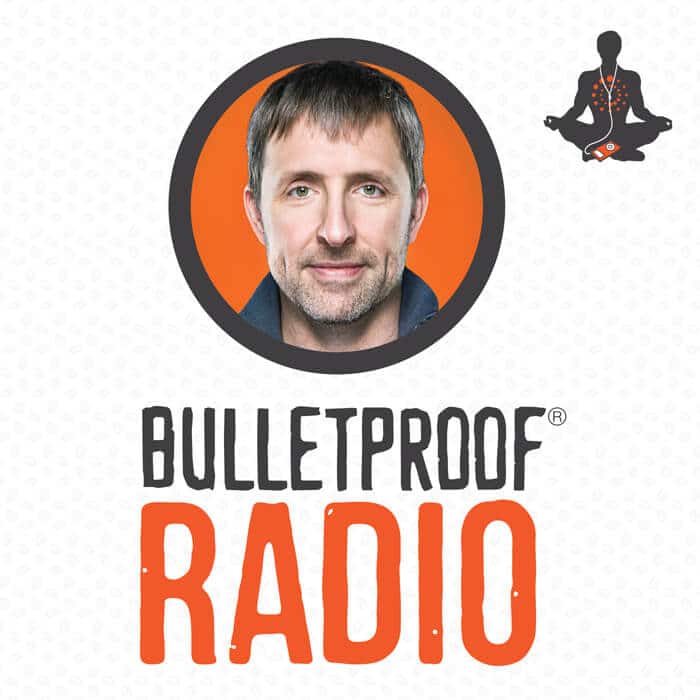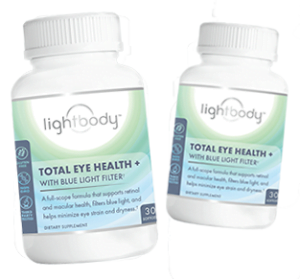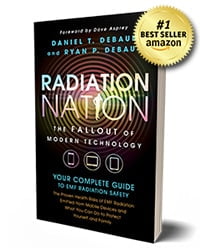Your cart is currently empty!

Dave Asprey – Protecting Yourself from EMF Radiation – Bulletproof Radio
Last Updated on November 19, 2022
Podcast Interview – Bulletproof Radio with Dave Asprey

DefenderShield founder Daniel T. DeBaun recently had the pleasure of being interviewed by Bulletproof CEO Dave Asprey on his popular Bulletproof Radio Podcast.
In the episode, Dave and Daniel discuss EMF emission health risks, Bluetooth vs. WiFi, European radiation standards, fallacies regarding Electromagnetic Radiation and more.
In this timely and engaging talk, you’ll learn about:
(note: timestamps represent audio, video may differ)
- 0:00 – Cool Fact of the Day
- 3:00 – Introducing Daniel DeBaun
- 5:42 – Electric fields & emissions
- 11:40 – Weakened fertility
- 19:07 – Emissions in the early-internet age
- 22:59 – Skeptics’ fallacies
- 26:35 – European emission standards
- 28:45 – Why isn’t exposure common knowledge?
- 33:22 – 3 ways to protect yourself from electromagnetic radiation
- 37:24 – Avoiding exposure in apartment buildings & traveling
- 43:05 – High voltage powerlines
- 47:58 – Safety of Bluetooth vs. WiFi
- 48:47 – Top 3 recommendations to kick more ass and be Bulletproof!
Listen or Watch in to learn more about Electromagnetic Radiation exposure and the effects on living organisms. There is a lot of great information so enjoy the show!
Listen
Watch
Read Entire Transcript
Dave: Hey it’s Dave Asprey with Bulletproof Radio. Today’s cool fact of the day is that a recently published 18 month long study concluded that power frequency electromagnetic frequencies actually did promote cancer in animals but that it matter whether or not the animals were also exposed to certain chemicals. In other words the chemicals themselves didn’t cause it and the EMF themselves didn’t cause it but the combination did cause it in this one study. This is in Spain.
A scientist called Elisabeth Cardis had an international here they looked at human workers exposed to chemicals and ELFs together and now an Italian team has found essentially the same effect in animals exposed to ionizing radiation and ELF/EMFs at the same time. You can read more about this kind of stuff in the Ramazzini experiment on microwavenews.com. We’ll of course link to that in the transcript of the show notes for the show. Just head on over to bulletproofexec.com and you can download all this and click on it and all that if that’s something you’re interested in. There’s definitely more than a few studies and some science books going back to the early 90s talking about this problem and all the research in it.
Before we get going on today’s show which as you might have already guessed because I forecast that for you we are going to be talking more about electromagnetic frequencies. I am incredibly stoked to share an innovation that has been under way for exactly 3 years at Bulletproof. Your mornings just got a lot easier and your days just got a lot more powerful because we are launching Instamix. What is Instamix you might want to know? Instamix is a powder that you add to your black Bulletproof upgraded coffee and you mix it with a blender or in a shaker cup and it makes Bulletproof coffee. It is just what you had imagined brain octane and grass-fed butter in a stable powder that mixes very, very easily.
Why did it take 3 years to do this you might ask? I’m unwilling to put crap in my Bulletproof coffee. We did the core chemistry and we got a really, really good product. I’m incredibly obsessive about doing this stuff right and you’ll find the ingredients are second to none. If you look at all the kind of things that you could easily do to make a quick and dirty powder with some MCT in it, this is about the opposite of that kind of thing. You’re going to be really, really stoked when you try it. It’s called Instamix. You can find it on bulletproof.com and this is basically a coffee creamer. You can take to the office. You can take with you on an airplane. Mix it with your Bulletproof coffee. I’ll show you on videos how to brew Bulletproof coffee beans wherever you are and you’re good to go.
Now onto to the show. Today’s guest is Daniel DeBaun who is the CEO of DefenderShield. DefenderShield is a company that has created effective electromagnetic radiation or EMF protection solutions. Most Bulletproof employees now have a DefenderPad which goes underneath your laptop to keep it from … how do I say this, keep it from frying your balls. Was that delicate enough Daniel?
Daniel: (Laughs)
Dave: Daniel’s a leader in shielding electronic emissions and protecting our bodies from this kind of radiation which obviously I would say there’s no evidence there’s benefit for us and there’s pretty good evidence that it causes harm, in fact some emerging science about how it works. Daniel has got a really interesting background which is why I brought him on the show. Aside from what he’s doing now, he started his career at Bell Labs which you may have also heard of throughout your life as AT&T Bell Laboratories or Bell Telephone Laboratories.
This is a research and scientific development company that started in the late 19th century and it was called the Volta Laboratory and Bureau. It was created by the guy who invented telephones. Researchers working there developed a few things you might have heard of like the transistor which allows us conversation to happen, the laser which is something I shot into my brain to make it smarter, the CCD which his actually how the cameras we’re using are connected, information theory which is probably how everything works. The operating systems like UNIX and the programming language C, C++, and one called S that really no one uses anyway.
On top of that we’ve got 8 Nobel Prizes awarded for people there. In other words this is a legitimate R&D thing. What Daniel did there is he’s a mechanical engineering by training but he ran the electrical Engineering Standards Division. This is a real scientist who spent his career working with electronics and figured out there’s something to pay attention to here. Daniel welcome to the show.
Daniel: Thanks a lot for inviting Dave. I really appreciate the opportunity to give me to chat with your audience. Thank you.
Dave: We’re going to have a fun conversation because you’re an interesting guy. I find that people who spend their whole career in something and then realize, “Oh wait maybe what I did was really good but maybe there were other downsides to it that I didn’t know about.” That becomes interesting. An example there one of the guys in the Bulletproof team created the cranberry bliss bar at Starbucks. Now he’s paying for his sins by working with a gluten free diet. That sort of thing happens. You go 1 direction, you go the other. You obviously believe that electronics or electronic fields can be a health risk or you wouldn’t have started your company but what led you to that conclusion? It’s hard to do that.
Daniel: We have a great story about that actually. Before I tell you about that I’ll give you a little bit of history so you can see how we got one place to the next. It turns out that at the divestiture I was in the development laboratories and we were developing digital thermal systems. Very, very complex communication systems and then there was divestiture that occurred. All of a sudden we had to develop standards and we had to make sure everyone who built equipment would meet those standards.
Dave: Divesture for people listening back when the Bell Labs were all basically government affiliated and/or controlled monopolies I forget which one. When there was a decision that you had to sell things off and become completive that was the divestiture time.
Daniel: We had divest the assets and break them out into separate entities for business. What happened is I ended up going from the development laboratories and then beginning to head up the standard work and the testing for electronic systems to make sure everyone is building the products that should be deployed in the telephone networks. For years and years and years that was my business. Ultimately I had a lot of background and very, very complex protocol, very, very complex technologies and I went to the office space and ultimately I retired fairly early.
A couple of years ago my sons they’re at home and they have their laptop in their lap. My wife says to them “I want grandchildren.” My wife didn’t know why she said grandchildren but she said “I want grandchildren.” Instantly I realized there’s a 0 to 10 gigahertz emissions coming out of that laptop and is very, very close to very, very sensitive parts of the body. No problem. Let’s go find something to protect the body. We went out and we couldn’t find one technology that actually solved the engineering problem which is you got to shield 0 to 10 gigahertz.
I said, “Let’s go build something.” We started building them and then all of a sudden our neighbors wanted them. Then their neighbors wanted them. Long story short 3 years later we sit here with a full portfolio of products all about protecting the full spectrum of emissions that are coming off of electronics today. It’s a great story. It was created out of necessarily.
Dave: In fact, hey Brock is there a DefenderShield sitting over there next to the …? People who are watching our YouTube channel, you should check it out. I’ll show you what one of these things work. This is what I gave to all the Bulletproof employees. You guys were kind enough to help us get these printed. It looks like a piece of plastic but it’s a little bit flexible. This is not one that I sell. This was a basic Christmas bonus gift for all the Bulletproof employees because I take care of my people including their fertility organs.
You basically set it on your lap and then the emanations from the laptop are going to go down where you want it to go. It’s a simple idea and its one that’s incredibly worth your time and attention unless you just believe that this doesn’t have an effect. Like “It’s all a hoax.” At that point we need to look at some of the evidence.
Daniel: Actually Dave one of the things about that specifically, one of the reasons why we quickly went after it is after just a few hours, the sperm count of the male is immobile, 25% of it. It actually stops operating. Oftentimes not understood is it’s also a problem for females. Something like 2% of the woman who uses it get a tumor related to it. A portion of that percentage becomes cancerous. There is clear evidence that substantiates the claim that there could be serious dangers with this stuff. It’s interesting you mentioned something about Bell Labs. Actually embedded in that product is something that came out of Bell Labs. When they put the underwater cables there was jacketing that they had to put around it to prevent the fish from getting …
Dave: I remember that.
Daniel: That’s what we used. We have to use some of that for the extreme frequency emissions at the very low end. Believe it or not.
Dave: Back when that was a problem I was at Exodus Communications. This is the first colocation company, Google’s first servers
Daniel: Yeah I remember.
Dave: We were lying on the very first fiberoptic trans-Atlantic cables and some of them were messed up by fish as I recall. Mostly though it was trolling ocean things but this is too funny. You actually use that cabling thing.
Daniel: That same technology. Actually there’s multiple emissions that come from a tablet, a cellphone. There are RF signals which are radiofrequency signals which are higher than the extremely low frequency emissions which are below 300 hertz. The only way you can eliminate that emission is by refracting the signal and that’s literally what we do. We refract the signal as it penetrates the materials.
Dave: That then prevents the sperm from being exposed.
Daniel: Literally.
Dave: That’s really interesting biochemical things that we’re starting to understand now. Your mitochondria, the power plants in the cell they’re superconducting and some of the other materials in the body are too. In fact all of our nerves apparently have some superconductive properties. What’s happening is that when you’re around these frequencies it reduces your mitochondrial function. When you look at what sperm do these are some of the most athletic molecules in your entire body. They have the most need for mitochondria. They’re little rocket ships basically and their job is to get there as fast as possible to that egg. If there is even a small decline in mitochondrial function, some of them aren’t going to get there and what we’re seeing is 25%.
Then we have Otto Warburg who is one of the big researchers theorizing what was going on with cancer and he’s looking at mitochondrial effects as a root cause of cancer. You get broken mitochondria, you get cancer. I’m particularly concerned. My first book was around fertility and it’s called the Better Baby Book. Widely published it and I was like, “There’s pretty clear evidence you want to put yourself in your front pocket.” You don’t want to put your laptop right over your reproductive organs.
What I didn’t put in that book is that a woman has many, many eggs and something decides which egg is going to be the one that matures and is basically the one that maybe fertilized. It’s the environment around that egg that does it. If you damage the mitochondria or at least inhibit their function, who knows if the right egg is going to come out based on the environment that you’re in. There’s all these subtler things that are field based and I think this is terribly important.
Daniel: Let’s chat a little bit about that. There are some experts I believe that under exposure of emissions the cell will basically stop functioning to some extent and not share the proteins between the cells so they get sick. Some argue that that’s the hypersensitivity symptoms related to that weakened cell. Others suggest that you have a weakened cell which is penetrated by the calcium channel which is standard in the bottom as you know.
Dave: Calcium influx
Daniel: Then there’s a buildup of nitrites within the cell and that converts to DNA damage. That mutates the cell. There’s all these arguments. Some of these physicians for the womb say, “What happens if you have a DNA cell within the womb?” It gets transported to the next generation. Some argue …
Dave: Mitochondrial DNA.
Daniel: Right. Mitochondrial DNA ends up …
Dave: It stays around forever with more defects.
Daniel: Exactly. Some argue it’s a huge problem but of course we don’t know because we’re not there yet.
Dave: The idea behind biohacking, the core tenet that supports all of my research and all the writing that I do is that you change the environment outside yourself and inside yourself so you have control of your biology and my very first book was like “Here’s what people are doing to systemically make our species weaker generation over generation.” Now that we know we can do that, here’s the best evidence for what you can do to make people stronger and specifically your own kids generation after generation.
One thing is in the months leading up to getting pregnant and during pregnancy like limit electromagnetic frequencies. You certainly not going to hurt yourself by doing that. You might not help yourself or your baby but I think you will. There’s enough evidence that this is really worth paying attention to.
Daniel: I don’t know if you know Cindy Sage she’s out of California. She’s the principal editor of BioInitiatives. You may have head of that BioInitiatives. It’s just a wonderful group that is brought together all of their intellectual knowledge to try to persuade the industries of the dangers related to emissions. What Cindy wrote in 2007 that miscarriages is 4 times likely if it’s an exposure of 16 milligals which is extreme low frequency emission measurements. Now that’s not a lot of stuff touching the body but she concluded based on her studies that it was 4 times more likely that there’d be miscarriage. In her view that’s serious. Do others believe that? Maybe not but certainly she found evidence to believe that.
Dave: There are a ton of naysayers out there and actually I don’t even know that that’s true. I think there’s a 2 to 5% psychologically damaged trolls out there who are very noisy and just love to enter debate because it makes them feel like better people. However, there are a few credible scientist who say “There was no evidence.” The way they do that is usually just by ignoring most evidence and saying there’s no evidence. When you look at some of the studies that have come out as far back as Robert O. Becker, electromagnetism and life. It’s very clear. We’re electromagnetic creatures. We’re chemical creatures. We’re both and neither one wins.
Daniel: It turns out that with the emissions exposures that we have that we’re learning more and more and more. There’s clearly more and more evidence profound more and more evidence but to get to the point you were making before it turns out that … I’ll go back to my lab days. I predicted the failure of systems out in the field. What I would do is I would then test that theory and so I would write probability statistics and I would say, “I need a sample size of 11,000 and then I’ll have a plus or minus 5 level of accuracy in what I produce.”
When I talk about this kind of stuff, I talk about statistics are just not there because we can’t take 11,000 children put them in a room and see who dies. The statistics are not substantive enough to prove without a shadow of a doubt that there’s a problem. We have the small studies but collectively these studies are becoming more and more significant.
When I started doing this work I found the industry fairly immature in understanding it particularly as it went through the public. I just didn’t think there was a real understanding on many people’s part and I would never ever say there’s some serious concerns with these kind of things. I wouldn’t say it. It was just not in my DNA. I can tell you without any doubt whatsoever with all this conclusive evidence that I’ve been able to find there’s no question that there’s impacts to the cell and in some cases very extreme.
Dave: There’s a couple of incidences throughout my career that come to mind when we talk about this. One of them happened in Mountain View, California probably 10 years ago. I sat down over coffee at a place called red rock coffee that’s still there. I used to go there to try and get beans that would make me feel good. They had a good selection of high quality coffee. Sometimes I could drink coffee there and be like “Yeah feel amazing.”
I met with this guy who had the very first patent for Wi-Fi, the first 802.11 patent. He had made his money and I’m forgetting his name right now. He basically said, “Check this out.” He opened up his laptop and he was using the million dollar test equipment they used to visualize fields so they could what was happening. He turned it around and aimed it at human beings. He’s like, “Look at all the data that’s coming off of human being when you just look with enough resolution.” He’s like, “I can already predict people with certain conditions just based on this stuff.”
This guy had no reason to … he wasn’t trying to make money. He already had money. He was just like, “I’m a curious engineer with crazy hair and I’m just doing this because it’s fun.” That gets my attention because he’s like you a scientist looking at … actually more an engineer and scientist but looking at the data. That’s really cool. Just 3 months ago I was with Peter Diamandis who wrote one of the quotes on the book for The Bulletproof Diet. He was on stage CTOs from most of the major virtual reality companies and I had a chance to ask these guys in the nicest professional way.
Like, “Hey whose job is it to make sure that you’re not frying our brains when you stick a cellphone especially with blue light going into our eyes affecting 25% of our brain with optical processing? Who’s job is it to make sure that you’re not screwing us up biologically?” they all looked at each other and they basically said, “Not ours.” There was no governing body that protects us from that kind of stuff. We’re doing amazing world changing technologies that I support but no one considers the downside until we’ve deployed billion internet of things everywhere and we’re cooking ourselves all the time.
Daniel: Dave, the standard for a cellphone.
Dave: Yup.
Daniel: It was created about 25 years ago.
Dave: We knew so much back then.
Daniel: That’s exactly right. A cellphone connection is a radiofrequency connection somewhere around 900 to 8 gigahertz somewhere in that range. By the way your microwave oven is [2.4 2 00:21:50] gigahertz. It’s the same thing except that it had more intensity. Why is that important? When you put a piece of meat into a microwave, what happens? The cells oscillate and it cooks the meat. Guess what? That’s going to happen to your head with the cellphone. It is identical signal.
Dave: I have a question about that though. Like there’s lots of studies I’ve seen say that the heating effects probably isn’t the issue.
Daniel: It’s not. That’s the point. When they establish the standard there was the thermal impact. It’s was the thermal not the biological. Of course when that man 30 years ago that 6 foot male that they did the test on to establish it, remember he didn’t have many friends who had cellphones. The period of time when they tested was not very long. The reality is kids 6 years old are using cellphones. That signal goes completely through the head. Thermally, increasing it by no more than 2 degrees so totally based on standard and we have no idea about biological impact.
Dave: Let’s zoom in on that a little bit more because the assumption and all of the skeptics out there say the only … this is an assumption that is not proven and not even tested well will say the effect is a thermal. It’s a heating effect. Since it doesn’t heat the head enough to matter therefore there is no effect. That is a logical fallacy because the whole assumption is flawed. What you and I are talking about is that the signal from these things disrupts biological activity not because it makes it hotter but because it affects the very mechanisms of the cells themselves. Every skeptic out there falls on that same old assumption. What you’re saying is that the heating assumption itself is also flawed because in kids they do get a hotter brain.
Daniel: Right. No question about it. By the way that signal 25, 30 years ago when the FCC established the 1.6 volt lots per meter square standard that signal was the maximum for occasional use. Everyone is using it more and more and more and it was an analog signal. You would know what an analog signal is.
Dave: Yeah.
Daniel: An analog signal is a constant load. Today’s signals are digital signals. They are pulsing loads. If you were to come to my laboratory 20 years ago and you said “Test my system because I want to see what it does because I think it’s exactly the same thing that’s analog to digital.” I’ll kick you out of my lab.
Dave: They’re just different animals.
Daniel: They’re totally different. The way I describe it is simple. You take a metal rod and you stick that metal rod on a piece of concrete, put 10,000 pound load on it, that concrete will not break. If you take that same rod 10,000 load, move the load, put the load back on, remove the load, put the load back on, the concrete breaks. Why? It’s a different load. It’s a fundamentally different load. That different load has an effect on the cell and it may be the same but it may not be but you can’t claim it’s the same without the study.
Dave: This is so funny. For 5 years for the University of California, I ran their web and internet engineering program. I taught how this stuff works. Usually a couple of levels out but I did the full OSI stack. All the engineers know what that means. In fact Bell Labs as I recall had to define OSI. You might had done work.
Daniel: Mostly we’re at the third but then we pushed up.
Dave: There you go. Now we totally got to geek out on that. I was like, “How would I explain the difference analog and digital?” I was thinking if you were to push against a pane of glass and push a little bit but you’re always pushing. Just slight differences the glass probably won’t break. If you pound, pound, pound, pound It’s going to break.
Daniel: It’s the same difference.
Dave: It was funny. You came with the jackhammer analogy but it’s that kind of thinking. This is everything in nature is analog. What that means is that the waves move slowly and most of our digital technologies are smack, smack, smack. They’re either on or off. In life we get warmed and cooled, warmed and cooled. That difference it actually matters and people do say “It doesn’t matter.” They’re just assuming something so they can justify whatever they want. You got to prove your assumptions to be a real scientist.
Daniel: Dave, if you lived in Europe the signal from your cellphone would be half the energy level as the US.
Dave: I didn’t know there was a difference in standards there.
Daniel: Absolutely. The way they make it different is to find the area of the space that heats up. They double the size. To be able to achieve that, they have to cut half the load the energy level.
Dave: Why did the European government do this?
Daniel: That’s an interesting question. My guess is they seem to have a better more mature understanding of the technologies that are evolving and they do something about it. You go to Europe we’re talking about actually low frequency emissions. In Sweden if its more than 4 milligals, it’s unacceptable. You know your tablets generates 10 milligals and you put it on your lap. That’s 3 times what Sweden would accept.
Dave: Then buy a Swedish laptop is it going to be …
Daniel: It’s different. The standards for emissions from those technologies there are different than here.
Dave: That’s an interesting strategy. Buy a European laptop even if it has a weird keyboard you could probably adjust it to the American keyboard.
Daniel: It may be.
Dave: This brings up a broader issue and maybe when we won’t get to into on this. One of the things that pisses me off about coffee America has no standards for a mitochondrial toxin and all this stuff is illegal to self in Europe. They’re like, “We’re not drinking that swill.” Then they send it over to the US and I’m lobbying for us to have the same level as like Japan, China. China for god sake has coffee standards and the US doesn’t. It’s the same thing with electronics. What the hell? We deserve the same kind of treatment as other countries. Let me tell you precaution is a really good thing to do when you’re doing with your babies. This is our lives and the next generation. We got too surrounded with that stuff. Hold on unless it makes money in which case just go for it.
Daniel: With the way we look at it is we’re not victims. We can’t change our environment around us but we can change how we deal with the technology in our space. I want to go back to something though we were talking about before that I think is important to know. How come it’s not common knowledge that we have exposures unlike anything we’ve seen in our lives, our children’s lives will see different. Our lives were different.
Why don’t we know more? I’ll often cite the cigarettes industry. If you look at the cigarettes industry 40 years ago. I’m older than you so I smoke cigarettes at 12 years old. Why? I was a big guy. Nothing wrong with it. There’s nothing going to bother me and my health about it. It was clearly at that time not a problem. Yet at that time science knew it was a problem. What happened? In fact I still remember 1978 the chairman of Philip Morris was asked by a group of physicians in England, “Will smoking affect a woman when she’s pregnant?” He said, “No, absolutely not it won’t but the baby may be smaller.” What mother wouldn’t want a smaller baby? That was the mentality at that time in 1978.
Dave: They hurt less coming out basically.
Daniel: Right. It was bizarre that was an acceptable argument in 1978.
Dave: I was 6 years old then. My God!
Daniel: If you think about it what changed that world? It was the courts. It wasn’t the science. Science already knew it. It was the courts that changed the view of the public knowledge on the technology where the cigarette smoking is linked ot cancer. I think that’s what’s going on here.
Dave: One of my great hopes is that by interviewing you and by talking about these things in an open manner that we can change things because I have a whole bevy of electromagnetic devices that increase mitochondrial function, that make people stronger and I am 1000% convinced, that’s a very scientific measure. I’m very convinced that we can design lighting systems including LED lighting systems that don’t mess up our brain. In fact I think we can make wireless like Wi-Fi routers that make human stronger and healthier if you acknowledge those in effect then you can attenuate the fields and suddenly we’re walking around feeling great.
The trillions of dollars that are to be made when we acknowledge the problems that we’re causing what we do now and then we reengineer and redeploy like if I was sitting there at wherever Bell Labs is now, where Samsung or somewhere else I’d be like “Guys if there was an issue here why don’t we make the world’s first healthy Wi-Fi that doesn’t mess people or makes them stronger.” They’re going to dominate the industry. I guarantee it. It’s going to take 20 more years.
Daniel: In the laboratories right now they’ve got optical interconnection with Wi-Fi. It’s a carrier. The carrier is not an RF signal. It’s an optical signal.
Dave: Lighting signal that can’t see. There are questions though because our cells are sensitive to light frequencies we don’t see as well. I’ve been looking at some of that stuff. That’s probably better than EMFs but I think it might really trash our eyes and some of other cells like cell brain stuff.
Daniel: You made a reference to the blue light that’s more and more of a challenge because of the technologies we’re using. People using displays.
Dave: Who knows maybe some of the frequencies … I know ultraviolet and infrared both have cellular mitochondrial effects. It’s like, “Man we got to work something out.” Who knows maybe pulsing the stuff, the EMFs isn’t a bad thing if we go back to an analog signal. There are ways.
Daniel: There’s no question about it. That was more safe. It wasn’t as threatening to the body. Also what’s true as well is the signal today can be half the signal that it was 10 years ago. Why? There’s cell towers everywhere. Why do you really need all these strong signals coming out of technology today?
Dave: That’s true. Let’s talk about that. There are 3 ways you can protect yourself against the electromagnetic radiation. What are they? If someone is concerned about this, what are the 3 things?
Daniel: It’s a great question. There’s 2 forms of electromagnetic radiation you got to worry about. You got to worry about the stuff that’s really close to you and then you got to worry about the stuff surrounding you. The stuff that’s really close to you like a cellphone. A cellphone by the way emits an RF signal for the tower. A Wi-Fi signal for the router, a Bluetooth signal for connecting in your car, the voice signaling used for communication in the car. There’s 3 signals coming out of that.
One of the very first things you typically should do is reduce the number of signals that is being transmitted by the stuff that’s close to you. It’s as simple as that. Turn off the Bluetooth if you’re not using it. Turn off the Wi-Fi if you’re not using it. That’s 1 simple thing you can do. Another is, do you know that and you would understand this if it’s a foot away it’s a logarithmic reduction. One foot 80% of the danger is gone.
Dave: We’re used to as human being recent thinking that if its 1 inch away that’s okay. If its 2 inches away, it’s just going to be twice the difference but it’s not. It goes up way more rapidly. Even just a couple of inches is way better than 1 inch.
Daniel: Absolutely. Twelve inches is 80% danger is gone, 4 foot 98% is gone.
Dave: The cell towers are a mile away from me now so I don’t have to worry about them.
Daniel: You don’t worry about those. No. Generally speaking you don’t worry about the stuff that’s surrounding you that’s not in your space. I said the other thing is the farther away. This is the part that I find quite disturbing is the environment in a school where we have all these electronics now being used by our kids. First of all we don’t know the impact the child but we do know that the penetration of those signals go far beyond what they go in in an adult male or adult female. It penetrates the bones because of the composition of the body at a younger age is more susceptible to the emissions.
Now what we’re doing is we’re creating an environment in which we have potentially 1 device generating 3 to 4 emissions times the number of devices in the room plus the equipment that’s receiving and transmitting. What kind of environment is that? I like to create an analogy for that where, am I worried about 1 bee in the room? Am I concerned that that bee is going to bother me and hurt me and destroy me? Ultimately no.
Am I worried about 1000 bees in a room? You bet. That’s the environment that you can find yourself in, public environments where you have all these transmitters around you. The signal level of those environments are a third of the standard level. In other words it’s not miniscule it’s a lot for an environment like that and its low energy over very long periods of time. What’s the impact of that? I don’t know.
Dave: I have similar concerns and I go to New York or LA and you go to a hotel and you turn your laptop or your phone and you see 85 wireless signals like routers. I’m not sure that my cells are prepared biologically evolutionary for that environment. I’m also not sure that it’s causing harm but I do know that if you have a bunch of that stuff at the head of your bed, your sleep quality will go down and I’ve had clients who are like, “Hey move your bed.” Then they can sleep or turn off your Wi-Fi and then you sleep. We have no Wi-Fi signals at all.
Then I turn on Wi-Fi during the day when I need it and then at night we have switch that turns off the Wi-Fi. We sleep pretty well. I’m on an organic farm. Most people aren’t going to do that. What would you do if you lived in say a high rise in New York and there’s a Wi-Fi in every apartment around you. You’ve got your own. You’re got your cellphone on and there’s an antenna on top of you building. You’re in a chaotic EMF environment. What are your options?
Daniel: There aren’t many. That’s one of those environments we can help people by describing actions they can take, where they put their routers, when they turn it on, when they turn it off. Not putting it in the bedroom. The worst place you can put electronics is in the bedroom because it’s long durations of exposure. You work those issues. In extreme cases, people buy these electromagnetic radiation shields that they put around their beds some with the grounding pads. I don’t believe in grounding pads. They use grounding pads. There are some things that they can do.
Dave: Why do you not believe in grounding pads? I’d love to hear your theory. I’ve used one. It seems to help my sleep and my jet lag quite a lot.
Daniel: Here you go. You put your cellphone on your desk and put your grounding pad 3 foot away and you’re not on the grounding pad. In fact even if you were on the grounding pad and you didn’t have socks and shoes on and you had your feet grounded to the pad, what’s the problem? A large signal is omnidirectional. It goes in all directions. It doesn’t go to that ground pad. It’s in the room. RF is attracted to a ground pad if it’s done ground to ground but it still permeates the air as it passes through towards the ground. If you’re looking to do grounding because you’re using a lot of electronics, there may be some benefit but there’s not significant benefit because the transmitters are constant.
Dave: If you’re wearing shoes and socks, it’s not going to work.
Daniel: Right because you’re not grounded.
Dave: What I do is I have either grounding sheet on the bed so I’m naked when I’m on it or when I travel lately I’ve been using a pillow case because it’s less weight to travel with. Then my body is grounded and certainly for jet lag I have no doubt that that works. That is a very obvious feeling. Whether that’s going to protect me from EMFs I don’t really know to be honest but I do know that I feel better when I use it.
Daniel: It turns out that the extreme low frequency stuff. We’ll refer to this a couple of times. Extreme low frequency is anything under 300 hertz. Anything below. The ground is like 3 hertz DC. Anything up to 300 hertz is what extreme low frequency emissions are. Extreme low frequency emissions will not be grounded by a pad. It just won’t. An RF signal on the other hand will and the way you know that Dave is if you had an old black and white television and you had rabbit ears antenna and you put aluminum on the head you got the signal a little bit better. Why? The aluminum attracted the signal. That’s what a grounding pad does. It helps attract the emissions.
Dave: Is the antenna on a TV like that? Is it grounded?
Daniel: They’re grounded. They are floating ground.
Dave: I wonder why it helps with jet lag. There’s a bunch of theories in the book about that. The book whose name I forget but Frank Sinatra looked at inflammation and dropping a static charge that builds up. It may simply just not be a shielding effect whatsoever but I think there is a change in voltage on the body that comes to.
Daniel: This is what I can tell you. Electromagnetic radiation everyone feels it differently. The more exposed you are over time, the more you may have developing a reaction to that. That’s called electromagnetic hypersensitivity. What I know for sure is even a very, very little change in that field, that grounding field for example makes a big difference. Although I’m not a strong proponent, if you are sensitive to electric fields, I know for sure that you will benefit from those kinds of things because the slight change is enough to make you feel more comfortable.
Dave: I don’t know that I’m sensitive to electromagnetic fields. I do wonder what I did to myself back in the early days of cellphones not the briefcase sized ones but the flip phone. I used to drive for about 2 to 3 hours a day on the phone constantly by my head. I have lots of exposure to that. We’ll see if half my brain keeps getting bigger. We’re right by the end of the show and I wasn’t even going to ask you some of the questions I wanted. Would you be concerned if you live near high voltage power lines?
Daniel: Extreme low frequency emissions 60 hertz that’s what that is. I would never. The energy levels of that … they can be as high as 10,000 volt lines. They generate a significant energy which you have to be at least 200 yards or more away from those signals for it not to impact you.
Dave: If you believe that these don’t do anything, one of my favorite stories ever was this farmer … a power company came and they’re like, “We’re going to just run our high voltage power lines right through your farmland.” He’s like, “What the hell! I don’t want to do this. This isn’t healthy.” They’re like “Nope we’re going to use them.” They did and his response which was brilliant was to set up some equipment that used the field generated by those power lines to generate his own power.
Daniel: They’re that strong. Absolutely.
Dave: He’s powering his entire farm with basically the field from these things and then selling power back to the utility that he was basically stealing just by going into the field they put on his property that isn’t supposed to have any effect. Eventually they shut him down because he was reducing the amount of electricity through the line but he’s like, “Tell me your field doesn’t do anything. I just powered my farm off of it.” I wouldn’t live … in fact some of the houses we looked at buying her on Vancouver Island I’m like, “Too close to power substation.” I just don’t want my kids to be bathed in ELF. How many schools and playgrounds are right next to those? Quite a lot. With kids you don’t mess around with kids.
Daniel: By the way you trigger in my mind off the farm. When I was trying to explain to a friend of mine what electromagnetic radiation is I said it’s the man made stuff. When I said them, is your cow doesn’t emit electromagnetic radiation? The only electromagnetic radiation that comes is from stuff we build and design. It’s that stuff that you have to be worried about. One of the things that I was thinking about when you were talking about schools … by the way was there’s a physicist out of the UK. He’s retired now. His business was generating weaponry for the UK. His specialty was electromagnetic radiation.
In his view he considers the exposures in school systems weapons being used on children. That’s how serious he believes that is. I’m not sure I don’t know if we have enough evidence but you probably noticed that ADHD is growing. There’s a lot of [corollary 00:46:05] things happening in the medical community where there’s some evidence, some anecdotal other scientific facts talking about that relationship. That’s serious stuff.
Dave: We know enough now that the rule in the house is “Kids you don’t touch a cellphone or a tablet if it’s not in airplane mode. You don’t get hours and hours. You get half hour a week with a tablet. You use it playing logic game or something.” Occasionally they can talk on speaker phone on the cellphone but they’re not touching it. They can talk to grandma and grandpa or something.
Daniel: Right, exactly.
Dave: It’s weird. People are like, “Here talk on the phone.” I’m like, “My kids just don’t hold the phone up to their head and neither do I because it’s not a good idea.” Maybe it’s less harmful than I think it is but is it harmless? Absolutely not. There’s no evidence that it’s harmless. What about the Bluetooth? Is Bluetooth better?
Daniel: Think of it this way. A cell connection can go several miles. A Wi-Fi can go several hundred feet. A Bluetooth can go 30 to 50 feet. There are energy levels to get there. It’s relative. It’s much better than a cell tower connection but it’s still an RF signal. If it’s close to you and you can turn it off do it because we talked about the distance before. The other thing you’ve heard me mention is duration. It’s the distance and duration those are the things you need to worry about even all energy emissions like the 10 milligals that I mentioned before about the pregnant women. That’s relatively low energy levels. You want to try to even avoid those because they are playing with your cells.
Dave: I’m always throwing on the show here I use these blue buds headset things. They’re Bluetooth and I see what you’re doing. People listen they know what I’m doing 152 times 2 110 or so episodes a year which is a pretty tough schedule like the amount of time that I’m sitting here under bad lighting. I mean its good lighting for the video but it’s not biologically good lighting. I’ve thought about switching back to wired but it’s really nice to be able to move around on the set. I’m not sure having wireless thing stuck to my ear is a very good idea.
Daniel: My coaching is you should not use them by the way.
Dave: I thought about going back to the old way. Maybe I will but we’ll figure that out. These are really close to my brain. Going right into those little holes where my ear canals are.
Daniel: Unobstructed.
Dave: Yeah. I’m taking one for the team right now. We’re up on the end of the show and I want to ask you the question that I’ve asked every guest on the show which is that if someone came to you tomorrow and said, “Based on everything you’ve learned in your life, if I want to perform better as a human being like I want to kick more ass at everything I do, what are the 3 most important things I need to know? What would you say?”
Daniel: That’s an interesting question. It’s philosophical by nature.
Dave: It is and you can answer it with hard science or soft science, whatever works for you.
Daniel: Science is not always the definitive understanding of life. There’s just no doubt about that. You have to make sure that you understand the life influence by many things including science but make sure you understand as an individual and person. The other thing is you got to find ways of contributing. In our case, I almost don’t care if I sell a product. I really do think it’s important to try to help people understand that the environment they live in and I tend to have an experience base that helps understand the technical side of that and I try to share it with those that don’t have a full understanding of those technical details. I don’t know if I have a third.
Dave: Nothing else comes up, huh?
Daniel: Be kind.
Dave: There you go. Every night when I put my kids to bed I ask them amongst other questions like, what’s the one act of kindness you did today? How did you help someone else? There’s great value to that even though I don’t think we have a double blind study that says being kind is a good thing. We can all agree that it is. Where can people find out more about DefenderShield and the other stuff that you make?
Daniel: Actually they can go to our website and that’s defendershield.com. We spend a lot of time helping people understand the space in layman’s term. Learning section that we have spent a lot of time on where we share our knowledge and for people to understand the subject matter maybe a little bit better. Defendershield.com that is where they can look for more information. We’re also by the way releasing a book probably in the next 3 months or so. So many people have asked us about so many complex levels of details on the space that we decided we probably could help by bringing a book out. Really watch for our book a little bit.
Dave: Let me know when it comes out and I’ll make sure that we share that on social media and all. One of the reasons I had you on and people don’t have any idea about this but like I didn’t charge you or anything like that to be on here. We’re just giving out your url. There’s no slimy affiliate stuff. Sometimes I do affiliate things. It helps to pay for the cost of stuff. Radio shows are actually quite expensive to run if you do it right. We just had you on because I like what you’re doing and because you have all that info up for free. It’s the same philosophy I have which is 99% of the info that I’ve created is given away freely to help people. You don’t have to buy any of my stuff and people who do buy my stuff, they benefit. If they don’t, they still benefit. It’s a big deal.
Daniel: That’s the way we feel dude.
Dave: I feel that in what you’re doing and that’s why you’re on the show. Also what you’re talking about it matters. It matters on so many different biological levels. The evidence in my mind not necessarily that we’ve done a double blind study that showed causation correlation. My job throughout my career in tech is here’s how stuff works. You figure out things. If you want to break a system, that’s what’s hackers do. There’s a weak point and you stick our finger in there and then what do you know magically you can get in and steal passwords or whatever you want to do.
Our body is not that different. This is one of those things where if you wanted to break the core energy production systems in the body which have all sorts of weird effects, this is how you would go about it. It’s one of several different ways. I’m concerned about it and I’m taking steps in my own life including getting all of my employees a defender pad. That’s a big thing. I don’t know any other companies that do that.
In my environment turning off my Wi-Fi, putting less of it in. the connection we’re talking about its Ethernet. Good old fashioned category 6 cabling. Every room in my house including the bedrooms but not the bathrooms has plugins for it and I’ve developed the right hack for my iPad and also you can actually use wired Ethernet with an iPad which isn’t supposed to be possible but it does work. I live this stuff and it’s a pleasure to be able to interview you on the show and to be able to show people there are experts who are well credentialed, who care about the stuff and are sharing this information. Thanks Daniel for doing what you’re doing and keep on fighting the good fight and when your book comes out we’ll talk about it.
Daniel: Thank you so much Dave. We really appreciate the chance to chat with you and we loved bringing out products to your team because it was almost like kindred spirits in a sense. We got an opportunity to meet your team maybe a year or so ago. My boys were with me and your team were there. They were kindred spirits. We did appreciate having a chance to work more closely with you in various ways. Thank you so much for offering this time for us and we do enjoy working with you. Thank you.
Dave: If you enjoyed today’s episode of Bulletproof Radio well you know what to do. Head on out there and look at defendershield.com and consider protecting your balls. I think it’s a good idea or your ovaries as the case may be. In fact we could just be very scientific and say protect your gonads and we’ve covered both genders. Here’s the deal. It’s not just that. The stuff we’re talking about matters. Its stuff that you’re probably not going to see acknowledged for another maybe 10 years. In the past it would have taken 30 years, 40 years for the truth to come out because we relied on journalist and all that.
We did something interesting. we sold all of our media where the journalist are to big companies so that we don’t have to worry about them anymore because for the most part they’re not going to talk about this but now we have social media. We have people like me and thousands of others who are talking about what’s happening on the cutting edge. The net effect of this is really, really amazing. The net effect here is that we actually can cause change to happen faster. Not just technology is changing but our ability to communicate stuff with each other matter is changing.
This is why I started doing what I’m doing on Bulletproof and this is why I think you should check out some of the research on DefenderShield. Check out some of the research on Bulletproof and while you’re at it don’t forget to drink Bulletproof coffee. Get your brain octane. Get those ketones going in your brain because when you do that sort of thing your ketones make energy in the cells differently than sugar and that matters. Have an awesome day and I will see you on the next episode.
Thanks for watching. Get tons more original info to make it easier to kick more ass at life when you sign up with the free newsletter at bulletproofexec.com. Thanks for watching and stay Bulletproof.
More Information
Dave’s Bio
Dave Asprey, founder of Bulletproof is a Silicon Valley investor and technology entrepreneur who spent two decades and over $300,000 to hack his own biology. Dave is the creator of the widely popular Bulletproof Coffee, host of the #1 health podcast, Bulletproof Radio, and author of the New York Times bestselling book, The Bulletproof Diet. Through his work Dave provides information, techniques and keys to taking control of and improving your biochemistry, your body and your mind so they work in unison, helping you execute at levels far beyond what you’d expect, without burning out, getting sick, or allowing stress to control your decisions.
Daniel’s Bio
Daniel is a leader in shielding electronic emissions and protecting our bodies from potentially harmful EMF radiation. He’s spent his career as a technical expert in telecommunications, and now is highly focused on the Electromagnetic Radiation exposure from electronic devices. Daniel serves as CEO of DefenderShield, a health and wellness technology company that has created the most effective EMF protection solutions ever developed.
























































